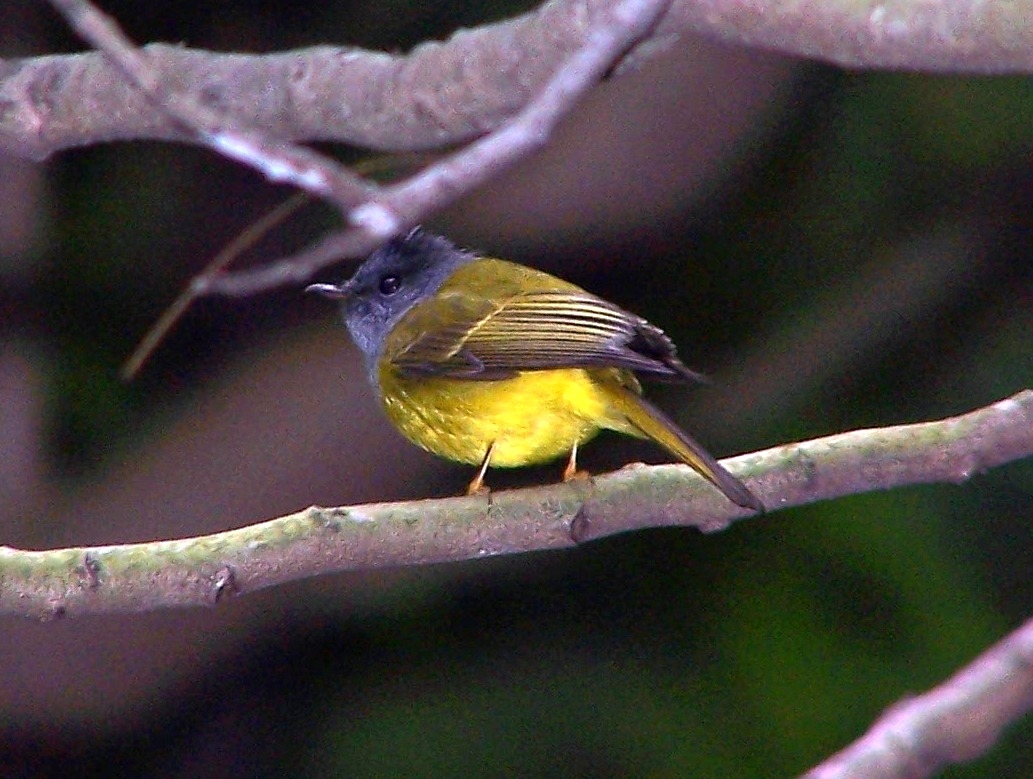- Stenostiridae
Taxobox
name = Stenostiridae

image_width = 250px
image_caption =Grey-headed Canary Flycatcher
regnum =Animal ia
phylum =Chordata
classis =Aves
ordo =Passeriformes
subordo =Passeri
familia =Stenostiridae
familia_authority = Beresford, F.K. Barker, Ryan & Crowe,2005 Stenostiridae is a family of small
passerine bird s proposed as a result of recent discoveries in molecular systematics (Beresford "et al." 2005). They are commonly referred to as stenostirid warblers.This new
clade is named after theFairy Warbler , a distinct species placed formerly in theOld World flycatcher s. This is united with the "sylvioid flycatchers": the genus "Elminia" (formerly placed in theMonarchinae ) and the closely allied former Old World flycatcher genus "Culicicapa". (Beresford "et al." 2005, Fuchs "et al." 2006)Its genera and
species are:* Genus "
Stenostira " – Fairy "Warbler" or Fairy "Flycatcher"* Genus "
Elminia " – includes "Trochocercus"
**African Blue Flycatcher , "Elminia longicauda"
**White-tailed Blue Flycatcher , "Elminia albicauda"
**Dusky Crested-flycatcher , "Elminia nigromitrata"
**White-bellied Crested-flycatcher , "Elminia albiventris"
**White-tailed Crested-flycatcher , "Elminia albonotata"* Genus "
Culicicapa "
**Grey-headed Canary-flycatcher , "Culicicapa ceylonensis"
**Citrine Canary-flycatcher , "Culicicapa helianthea"Other African or Asian species might conceivably fall into this novel
clade . Thetit-flycatcher s ("Myioparus ") are apparently true flycatchers morphologically somewhat convergent to "Stenostira" (Jønsson & Fjeldså 2006).The Stenostiridae as a whole are related to penduline tits, titmice and chickadees. All these appear to be closer to theSylvioidea than to otherPasserida , but this is not robustly supported by the available data and they might constitute a distinct, more basalsuperfamily .(Alström "et al." 2006, Beresford "et al." 2005, Barker "et al." 2004)References
* Alström, Per; Ericson, Per G.P.; Olsson, Urban & Sundberg, Per (2006): Phylogeny and classification of the avian superfamily Sylvioidea. "Molecular Phylogenetics and Evolution" 38(2): 381–397. doi|10.1016/j.ympev.2005.05.015
* Barker, F. Keith; Cibois, Alice; Schikler, Peter A.; Feinstein, Julie & Cracraft, Joel (2004): Phylogeny and diversification of the largest avian radiation. "PNAS" 101(30): 11040–11045. doi|10.1073/pnas.0401892101 [http://www.pnas.org/cgi/reprint/0401892101v1.pdf PDF fulltext] [http://www.pnas.org/cgi/content/full/0401892101/DC1 Supporting information]
* Beresford, P.; Barker, F.K.; Ryan, P.G. & Crowe, T.M. (2005): African endemics span the tree of songbirds (Passeri): molecular systematics of several evolutionary 'enigmas'. "Proc. Roy. Soc. Lond. B" 272(1565): 849–858. DOI|10.1098/rspb.2004.2997 [http://www.tc.umn.edu/~barke042/pdfs/Beresford.et.al05.pdf PDF fulltext] [http://www.journals.royalsoc.ac.uk/media/public/contributionsupplementalmaterials/h/y/b/7/hyb7fme16147k0d3/archive1.pdf Electronic appendix]
* Fuchs, J.; Fjeldså, J.; Bowie, R. C. K.; Voelker, G. & Pasquet, E. (2006): The African warbler genus "Hyliota" as a lost lineage in the oscine songbird tree: Molecular support for an African origin of the Passerida. Molecular Phylogenetics and Evolution 39(1): 186–197. doi|10.1016/j.ympev.2005.07.020 (HTML fulltext)
* Jønsson, Knud A. & Fjeldså, Jon (2006): A phylogenetic supertree of oscine passerine birds (Aves: Passeri). "Zool. Scripta" 35(2): 149–186. doi|:10.1111/j.1463-6409.2006.00221.x (HTML abstract)
Wikimedia Foundation. 2010.
